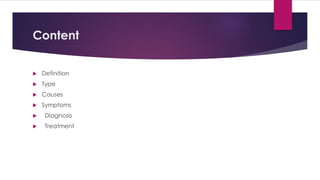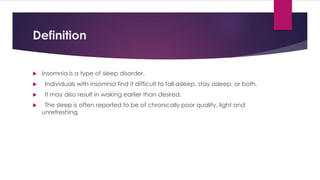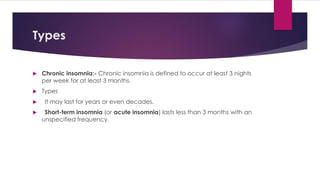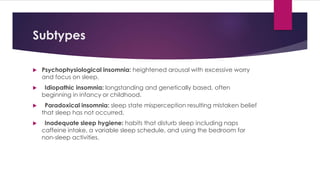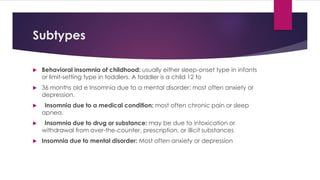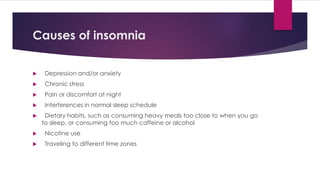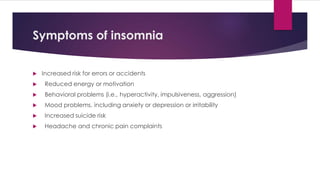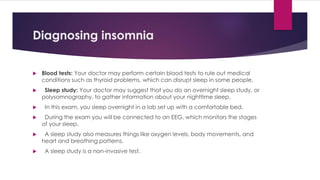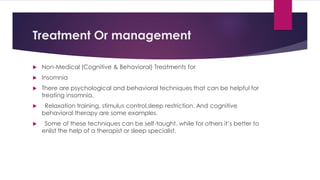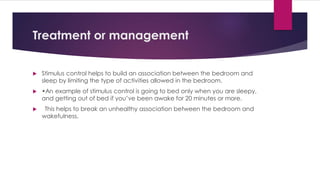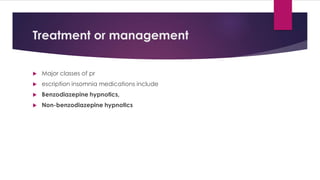Presentation citizenship.pdf
- 2. Content ïĩ Definition ïĩ Type ïĩ Causes ïĩ Symptoms ïĩ Diagnosis ïĩ Treatment
- 3. Definition ïĩ Insomnia is a type of sleep disorder. ïĩ Individuals with insomnia find it difficult to fall asleep, stay asleep, or both. ïĩ It may also result in waking earlier than desired. ïĩ The sleep is often reported to be of chronically poor quality, light and unrefreshing.
- 4. Types ïĩ Chronic insomnia:- Chronic insomnia is defined to occur at least 3 nights per week for at least 3 months. ïĩ Types ïĩ It may last for years or even decades. ïĩ Short-term insomnia (or acute insomnia) lasts less than 3 months with an unspecified frequency.
- 5. Subtypes ïĩ Psychophysiological insomnia: heightened arousal with excessive worry and focus on sleep. ïĩ Idiopathic insomnia: longstanding and genetically based, often beginning in infancy or childhood. ïĩ Paradoxical insomnia: sleep state misperception resulting mistaken belief that sleep has not occurred. ïĩ Inadequate sleep hygiene: habits that disturb sleep including naps caffeine intake, a variable sleep schedule, and using the bedroom for non-sleep activities.
- 6. Subtypes ïĩ Behavioral insomnia of childhood: usually either sleep-onset type in infants or limit-setting type in toddlers. A toddler is a child 12 to ïĩ 36 months old e Insomnia due to a mental disorder: most often anxiety or depression. ïĩ Insomnia due to a medical condition: most often chronic pain or sleep apnea. ïĩ Insomnia due to drug or substance: may be due to intoxication or withdrawal from over-the-counter, prescription, or illicit substances ïĩ Insomnia due to mental disorder: Most often anxiety or depression
- 7. Types ïĩ Primary insomnia: not directly associated with any other health condition or problem. ïĩ Secondary insomnia: because of something else, such as a health condition (like asthma, depression, arthritis, cancer, or heartburn); pain; medication they are taking; or a substance they are using (like alcohol
- 8. Causes of insomnia ïĩ Significant life stress (job loss or change, death of a loved one, divorce, moving) ïĩ Illness ïĩ Emotional or physical discomfort ïĩ Environmental factors like noise, light, or extreme temperatures (hot or cold) that interfere with sleep ïĩ Some medications (treat colds, allergies, depression, high blood pressure, and asthma) may interfere with sleep
- 9. Causes of insomnia ïĩ Depression and/or anxiety ïĩ Chronic stress ïĩ Pain or discomfort at night ïĩ Interferences in normal sleep schedule ïĩ Dietary habits, such as consuming heavy meals too close to when you go to sleep, or consuming too much caffeine or alcohol ïĩ Nicotine use ïĩ Traveling to different time zones
- 10. Symptoms of insomnia ïĩ Waking too early in the morning ïĩ unrefreshing sleep ïĩ trouble falling or staying asleep ïĩ Fatigue or daytime sleepiness ïĩ Poor attention or concentration ïĩ Impaired performance resulting in problems with work or social life and
- 11. Symptoms of insomnia ïĩ Increased risk for errors or accidents ïĩ Reduced energy or motivation ïĩ Behavioral problems (i.e., hyperactivity, impulsiveness, aggression) ïĩ Mood problems, including anxiety or depression or irritability ïĩ Increased suicide risk ïĩ Headache and chronic pain complaints
- 12. Diagnosing insomnia ïĩ There is no definitive test for insomnia ïĩ Sleep log: A sleep log is a simple diary that keeps track of details about your sleep. ïĩ In a sleep log, youâll record details like your bedtime, wake up time, how sleepy you feel at various times during the day, and more. ïĩ A sleep log can also help your doctor figure out what might be causing insomnia. ïĩ Sleep inventory: A sleep inventory is an extensive questionnaire that gathers information about your personal health, medical history, and sleep patterns.
- 13. Diagnosing insomnia ïĩ Blood tests: Your doctor may perform certain blood tests to rule out medical conditions such as thyroid problems, which can disrupt sleep in some people. ïĩ Sleep study: Your doctor may suggest that you do an overnight sleep study, or polysomnography, to gather information about your nighttime sleep. ïĩ In this exam, you sleep overnight in a lab set up with a comfortable bed. ïĩ During the exam you will be connected to an EEG, which monitors the stages of your sleep. ïĩ A sleep study also measures things like oxygen levels, body movements, and heart and breathing patterns. ïĩ A sleep study is a non-invasive test.
- 14. Treatment Or management ïĩ Non-Medical (Cognitive & Behavioral) Treatments for ïĩ Insomnia ïĩ There are psychological and behavioral techniques that can be helpful for treating insomnia. ïĩ Relaxation training, stimulus control,sleep restriction. And cognitive behavioral therapy are some examples. ïĩ Some of these techniques can be self-taught, while for others itâs better to enlist the help of a therapist or sleep specialist.
- 15. Treatment or management ïĩ Relaxation training, or progressive muscle relaxation, teaches the person to systematically tense and relax muscles in different areas of the body. ïĩ This helps to calm the body and induce sleep. ïĩ Other relaxation techniques that help many people sleep involve breathing exercises, mindfulness, meditation techniques, and guided imagery. Many people listen to audio recordings to guide them in learning these techniques.
- 16. Treatment or management ïĩ Stimulus control helps to build an association between the bedroom and sleep by limiting the type of activities allowed in the bedroom. ïĩ âĒAn example of stimulus control is going to bed only when you are sleepy, and getting out of bed if youâve been awake for 20 minutes or more. ïĩ This helps to break an unhealthy association between the bedroom and wakefulness.
- 17. Treatment or management ïĩ Cognitive behavioral therapy (CBT) includes behavioral changes (such as keeping a regular bedtime and wake up time, getting out of bed after being awake for 20 minutes or so, and eliminating afternoon naps) but it adds a cognitive or âthinkingâ component. ïĩ There is a good amount of research supporting the use of CBT for insomnia. ïĩ For example, in one study, patients with insomnia attended one CBT session via the internet per week for 6 weeks. After the treatment, these people had improved sleep quality.
- 18. Treatment or management ïĩ Avoiding caffeinated beverages near bedtime ïĩ Avoiding exercise near bedtime ïĩ Minimizing time spent on your bed when youâre not specifically intending to sleep, such as watching TV or surfing the web on your phone ïĩ Donât eat a heavy meal late in the day ïĩ Make your bedroom comfortable. Be sure that it is dark, quiet, and not too warm or too cold.
- 19. Treatment or management ïĩ Major classes of pr ïĩ escription insomnia medications include ïĩ Benzodiazepine hypnotics, ïĩ Non-benzodiazepine hypnotics

